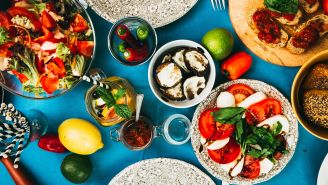It's great when restaurants offer "healthy" options on their menus, and more and more eateries are doing so. Foods that are described as “homemade,” “organic,” and “natural” have an aura of healthfulness and sound like they’d be good for you. But how nutritious are they, really?
Turns out, they’re often not very good for you at all.
A 2021 study published in the American Journal of Preventive Medicine revealed that restaurant menu items with descriptions like “healthy,” “fresh,” “organic,” “vegan,” “vegetarian,” “low calorie,” and “gluten-free” were not necessarily lower in saturated fat, sodium, or sugar than menu items that weren’t described in similar terms.
The truth about ‘healthy’ restaurant foods
In the study, researchers analyzed items on the menus at 96 of the top-selling U.S. restaurant chains between 2012 to 2018. Most main dishes with healthy descriptions were lower in calories than less-healthy sounding counterparts (with the exception of “organic” items, which contained more calories than non-organic options). At the same time, though, most “healthy” main dishes received more than 10 percent of their calories from saturated fat. This exceeds the recommended daily limit of less than 10 percent of daily calories from this nutrient, per the 2020-2025 Dietary Guidelines for Americans. The American Heart Association urges people to strive for 6 percent of calories or less from saturated fat.
Most “healthy” menu items, meanwhile, were lower in salt than their less healthy counterparts, but not by much. “Healthy” main dishes contained only about 180 milligrams (mg) less sodium than items without a healthy claim and contained on average about 1,300 mg sodium—which is more than half your daily recommended salt intake of 2,300 mg per day. Vegan and vegetarian desserts actually contained more sodium than other desserts.
Main dishes with healthy-sounding descriptions had the same or higher sugar content than items without these descriptions.
Nutrient overload
But what's a few more milligrams of salt or grams of sugar here and there?
Considering that about half of your risk for heart disease comes from factors that you may have some control over—including your diet—it matters quite a lot. And if heart disease runs in your family, making healthy lifestyle choices may help you counteract your genetic profile.
The bottom line: Don't rely blindly on what a restaurant menu might say and inadvertently let "healthy" menu choices sidetrack your healthy eating.
The good news is that there are proactive steps you can take to maximize the healthfulness of your meal when you dine out. Here’s how to take matters into your own hands:
Be wary of portion sizes. Some individual restaurant entrees could feed entire families, which means extra calories, saturated fat, salt, and sugar for you. Retrain your eye on what makes a healthful portion size.
If a dish arrives from the kitchen piled high, it’s probably too much food for one meal—regardless of whether the menu calls it a healthy option. Enjoy as much as you like until you start to feel about 80 percent full and then ask for a carry-out carton. Better still, set aside half of the plate up front, enjoy the other half, and keep the rest for tomorrow’s lunch.
Be choosy with your sides. In the study, some freebie sides described as healthy contained the same amount or more sugar than items without the healthy labeling. Choose healthful side dishes like steamed vegetables instead of those loaded with unnecessary extras like butter, cheese, or syrupy and sticky sauces.
Be picky with processed foods. Want to replicate your favorite restaurant treats with a premade version? Be sure read nutrition labels when you’re shopping the packaged food or frozen aisles at the supermarket. Just because an item is sold in the grocery store doesn’t necessarily mean it’s more wholesome than something you’d find at a restaurant.







